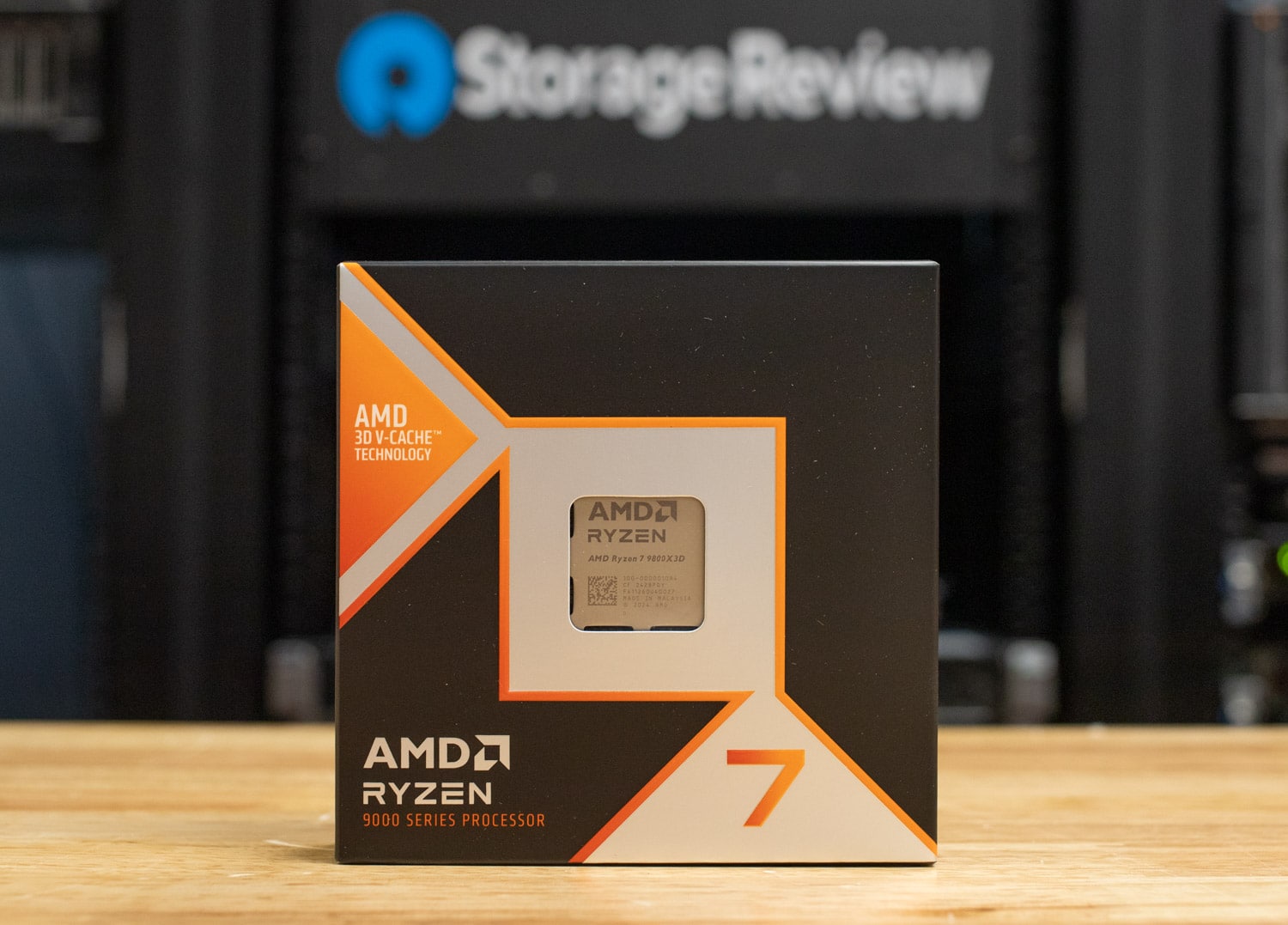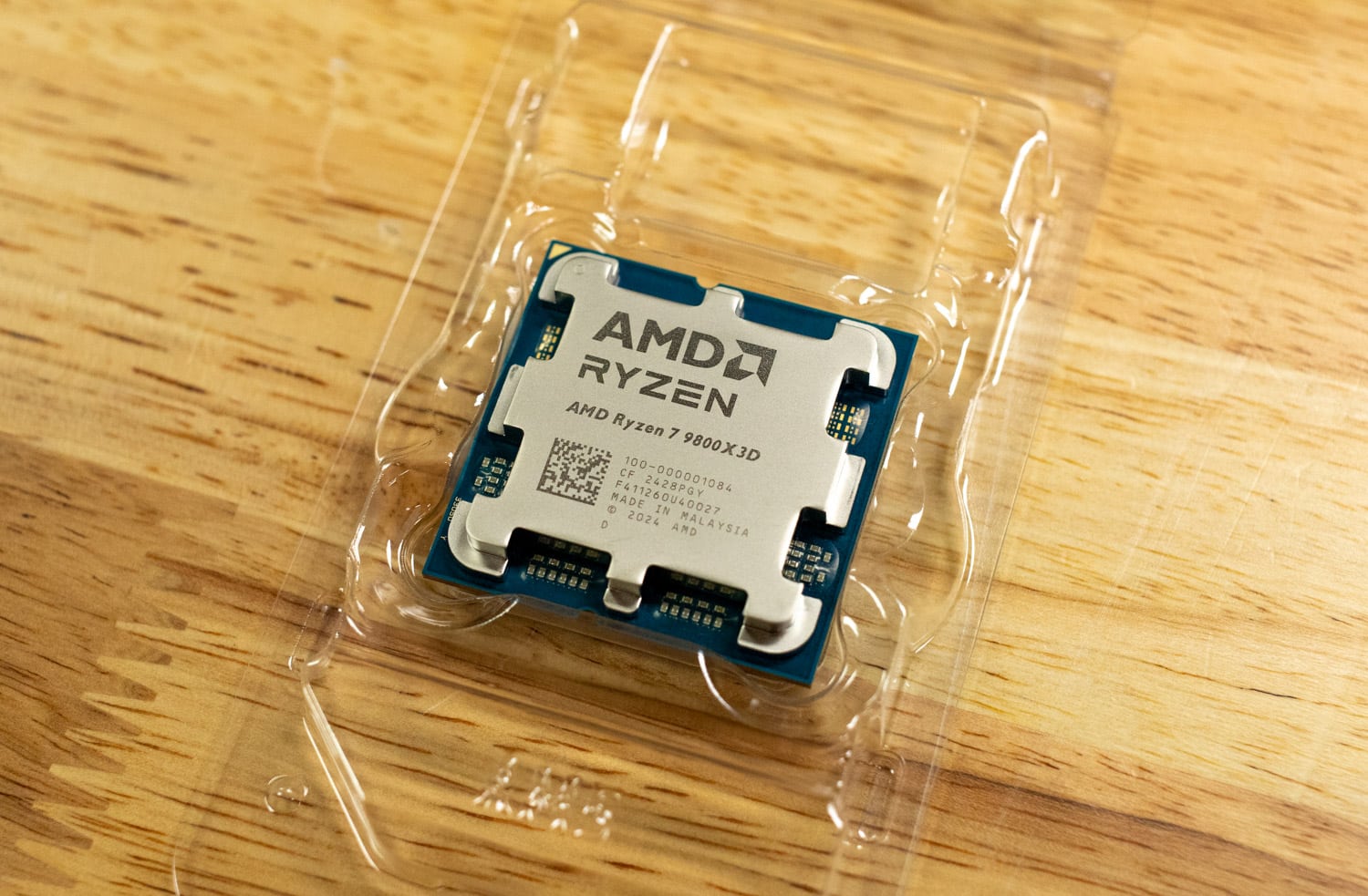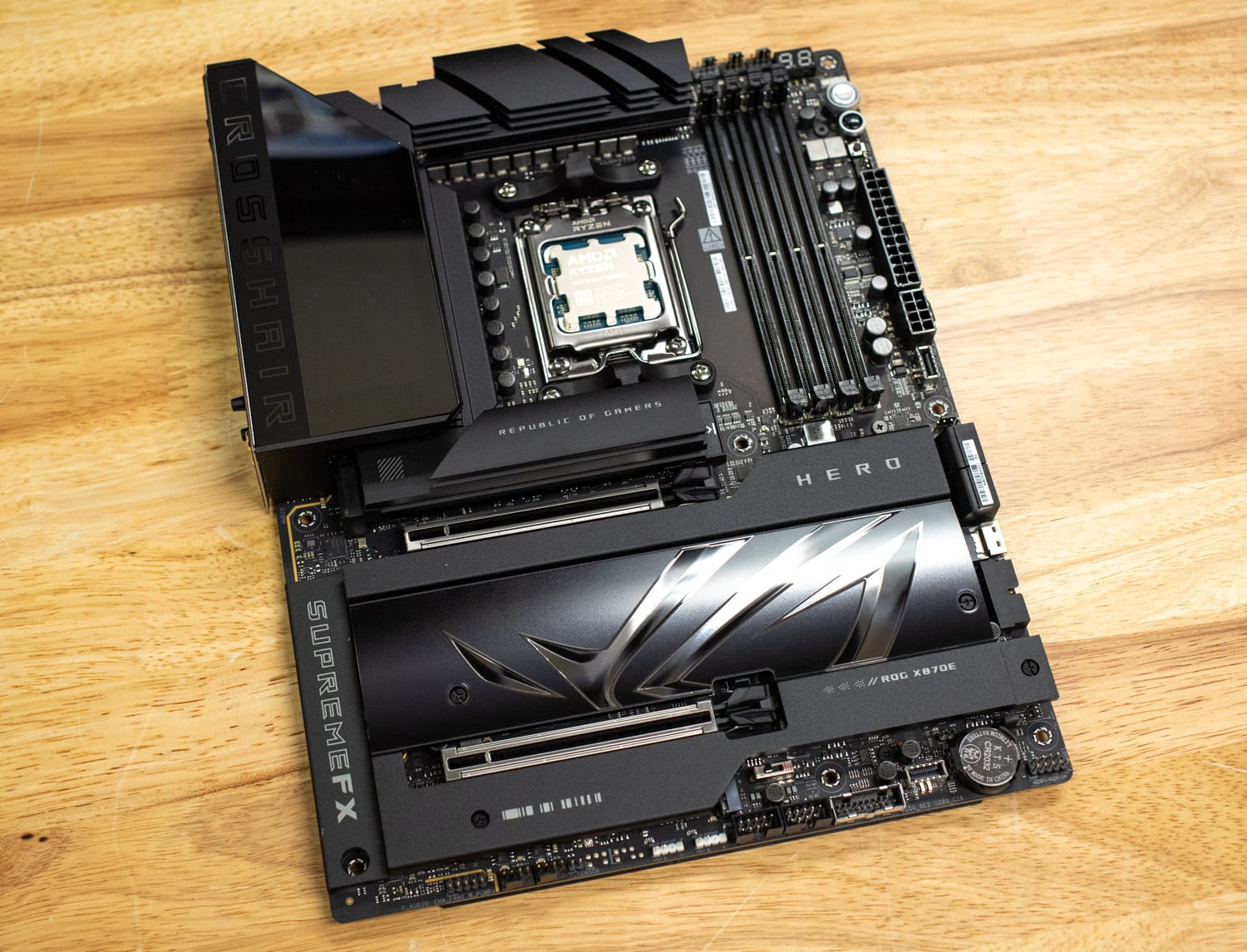AMD’s Ryzen 7 9800X3D stands as a flagship processor specifically designed for gamers demanding peak performance. Building upon the success of its predecessor, the 7800X3D, this new chip combines massive cache capacity, overclocking capabilities, and full compatibility with AMD’s advanced 800-series platform. The processor’s standout feature remains its innovative 3D V-Cache technology, which has become a hallmark of AMD’s high-performance gaming solutions.
AMD Ryzen 7 9800X3D Specifications
The Ryzen 7 9800X3D comes on the heels of the Ryzen 9000 series debut. The new Zen 5 architecture emphasizes performance improvements in single- and two-thread operations, a higher bandwidth and lower latency memory subsystem, and superior energy efficiency. For the lowdown on Zen 5, see our AMD Ryzen 7 9700X review.

Here’s a comparison of the Ryzen 7 9800X3D to its predecessor, the Ryzen 7 7800X3D, and the Ryzen 7 9700X on which it’s based. These are all eight-core/16-thread parts.
| Ryzen 7 9800X3D | Ryzen 7 7800X3D | Ryzen 7 9700X | |
| Architecture | Zen 5 | Zen 4 | Zen 5 |
| Boost/Base Clocks (GHz) | 4.7/5.2 | 4.2/5.0 | 3.8/5.5 |
| L2 Cache | 8MB | ||
| L3 Cache | 96MB | 32MB | |
| TDP/cTDP | 120W | 65W/120W | |
| TjMax | 95 C | ||
| AMD Recommended Cooler | 240-280mm liquid | Air cooling | |
| Max Memory Speed | DDR5-5600 | DDR5-5200 | DDR5-5600 |
The Ryzen 7 9800X3D’s clock speed bumps are courtesy of a new physical design that places the 3D-V cache beneath the processor cores on the CPU die instead of on top, putting the cores closer to the cooling solution. This is a significant improvement over older X3D chips, which had the 3D-V cache positioned atop the processor die. The previous design created a blanket effect that trapped heat, and the 3D-V cache layer’s smaller size compared to the processor die required AMD to use filler material, compromising thermal performance.

AMD claims significant cooling benefits and improved multi-core residency with this new under-die cache placement, providing greater cooling headroom. Unlike the Ryzen 7 7800X3D, the new chip is also overclockable, with the same clock and voltage limits that apply to the standard Ryzen 9000 series CPUs — a feature made possible by the improved thermal characteristics of the new design.
AMD Ryzen 7 9800X3D Performance
We tested the Ryzen 7 9800X3D using an AMD-supplied Asus ROG Crosshair X870E Hero motherboard with a liquid-cooling solution and Windows 11 Pro. All tests were run with G.SKILL Trident Z5 Royal Series DDR5-6000 (2x16GB) on EXPO 1 and using the processor’s integrated graphics. We also performed some mild overclocking tests.

We will compare the Ryzen 7 9800X3D to the Ryzen 7 9700X and its two-generation-old predecessor, the Ryzen 7 5700X3D.
3DMark CPU Profile
The 3DMark CPU Profile benchmarking tool is tailored to gauge CPU performance through custom simulations. This benchmark includes six tests, each employing the same workload but with varying threading capacity. These tests are meticulously designed to challenge the CPU across different threading levels — 1, 2, 4, 8, 16, and up to the maximum available threads of a given system.
We see significant generational gains immediately from the Ryzen 7 9800X3D, with a 14% higher max threads score than the Ryzen 9 9700X. They have similar one-thread scores, which is expected given their comparable boost clocks. The Ryzen 7 5800X3D is completely outclassed, as it will be in all the other tests.
| 3DMark CPU Profile (Higher is better) | AMD Ryzen 7 9800X3D | AMD Ryzen 7 9700X | AMD Ryzen 7 5700X3D |
| Max Threads | 10,121 | 8,845 | 8,256 |
| 16 Threads | 10,023 | 8,854 | 8,244 |
| 8 Threads | 8,699 | 7,952 | 7,002 |
| 4 Threads | 4,744 | 4,881 | 3,878 |
| 2 Threads | 2,431 | 2,550 | 2,066 |
| 1 Thread | 1,221 | 1,286 | 1,044 |
Cinebench
Cinebench is a widely used benchmarking tool that measures the performance of CPUs and GPUs using Maxon Cinema 4D for rendering. It provides a score that can compare the performance of different systems and components.
Here we see the Ryzen 7 9800X3D take a sizable 15.6% lead over the Ryzen 7 9700X in Cinebench R23 multi-core, though it was about 100 points behind in single core. We saw similar results in Cinebench R24.
| Cinebench CPU Testing (Higher is better) | AMD Ryzen 7 9800X3D | AMD Ryzen 7 9700X | AMD Ryzen 7 5700X3D |
| Cinebench R23 | |||
| Multi-Core | 22,986 | 19,884 | 13,897 |
| Single-Core | 2,110 | 2,206 | N/A |
| Cinebench R24 | |||
| Multi-Core | 1,358 | 1,178 | 789 |
| Single Core | 134 | 137 | 86 |
y-cruncher
y-cruncher 0.8.3.9522 is a multi-threaded, scalable program that can compute Pi and other mathematical constants to trillions of digits. Since its launch in 2009, it has become a popular benchmarking and stress-testing application for overclockers and hardware enthusiasts.
The Ryzen 7 9800X3D again outperformed the Ryzen 7 9700X, with lower times in all tests.
| y-cruncher (Total Computation Time in seconds) | AMD Ryzen 7 9800X3D | AMD Ryzen 7 9700X | AMD Ryzen 7 5700X3D |
| 1 billion digits | 19.577 | 21.658 | 36.819 |
| 2.5 billion | 58.512 | 62.456 | 107.360 |
| 10 billion | 130.845 | 132.758 | 242.147 |
y-cruncher BBP
This y-cruncher benchmark utilizes the Bailey-Borwein-Plouffe (BBP) formulas to compute massive hexadecimal digits of Pi, measuring the CPU’s total computation time, utilization, and multi-core efficiency.
Perhaps the extra cache on the Ryzen 7 9800X3D helps it in these calculations, as the performance gains are significant; it completed the 100 BBP test in just 78% of the Ryzen 7 9700X’s time.
| y-cruncher BBP | AMD Ryzen 7 9800X3D | AMD Ryzen 7 9700X | AMD Ryzen 7 5700X3D |
| 1 BBP | Total Time: 0.658 seconds
CPU Utilization: 1441.84% Multi-core Efficiency: 90.11% |
Total Time: 0.865 seconds
CPU Utilization: 1332.81% Multi-core Efficiency: 83.30% |
Total Time: 1.946 seconds
CPU Utilization: 1523.06% Multi-core Efficiency: 95.19% |
| 10 BBP | Total Time: 7.413 seconds
CPU Utilization: 1,567.21% Multi-core Efficiency: 97.95% |
Total Time: 9.552 seconds
CPU Utilization: 1578.20% Multi-core Efficiency: 98.64% |
Total Time: 21.554 seconds
CPU Utilization: 1588.88% Multi-core Efficiency: 99.31% |
| 100 BBP | Total Time: 83.204 seconds
CPU Utilization: 1596.29% Multi-core Efficiency: 99.77% |
Total Time: 105.559 seconds
CPU Utilization: 1593.16% Multi-core Efficiency: 99.57% |
Total Time: 240.543 seconds
CPU Utilization: 1596.35% Multi-core Efficiency: 99.77% |
7Zip Compression Benchmark
The built-in memory benchmark in the 7-Zip utility measures the performance of a system’s CPU and memory during compression and decompression tasks, indicating how well the system can handle data-intensive operations. We run this test at a 128MB dictionary size when possible.
The Ryzen 7 9800X3D and Ryzen 7 9700X fared about evenly here, which is expected considering it’s heavily memory-based and the two chips share the same memory controller.
| 7-Zip Compression Benchmark (Higher is better) | AMD Ryzen 7 9800X3D | AMD Ryzen 7 9700X | AMD Ryzen 7 5700X3D |
| Compressing | |||
| Current CPU Usage | 559% | 534% | 811% |
| Current Rating/Usage (GIPS) | 21.272 | 22.369 | 8.651 |
| Current Rating (GIPS) | 118.906 | 119.355 | 70.151 |
| Resulting CPU Usage | 559% | 541% | 820% |
| Resulting Rating/Usage (GIPS) | 21.314 | 22.201 | 8.529 |
| Resulting Rating (GIPS) | 118.885 | 119.964 | 69.965 |
| Decompressing | |||
| Current CPU Usage | 1549% | 1571% | 1587% |
| Current Rating/Usage (GIPS) | 8.641 | 8.290 | 6.398 |
| Current Rating (GIPS) | 133.805 | 130.245 | 101.553 |
| Resulting CPU Usage | 1564% | 1570% | 1586% |
| Resulting Rating/Usage (GIPS) | 8.535 | 8.296 | 6.358 |
| Resulting Rating (GIPS) | 133.466 | 130.281 | 100.861 |
| Total Rating | |||
| Total CPU Usage | 1061% | 1056% | 1203% |
| Total Rating/Usage (GIPS) | 14.924 | 15.248 | 7.443 |
| Total Rating (GIPS) | 126.176 | 124.988 | 85.413 |
UL Procyon
UL’s Procyon AI Inference benchmark suite tests how various AI inference engines perform using state-of-the-art neural networks. We ran these tests only on the CPU.
These AI tests aren’t ideal for CPUs, but this test might actually benefit from the Ryzen 7 9800X3D’s immense L3 cache; it scored 22% better than the Ryzen 7 9700X.
| UL Procyon (Higher is better) | AMD Ryzen 7 9800X3D | AMD Ryzen 7 9700X | AMD Ryzen 7 5700X3D |
| Overall Score | 275 | 225 | 128 |
AMD Ryzen 7 9800X Overclocking
We overclocked the Ryzen 7 9800X3D by enabling AMD’s Precision Boost Overdrive (PBO) and setting the overdrive scaler to X9, the max CPU boost clock override to +200, and the curve optimizer to -12. As advised by AMD, we followed this process in the motherboard’s BIOS.
- Enable PBO Advanced.
- Set PBO Scalar between 7-10X.
- Set the CPU Boost Clock override between +100-200MHz.
- Set the Curve Optimizer steps, starting in the -10 to -15 range.
PBO (Precision Boost Overdrive) allows the CPU to use its boost clock more aggressively and primarily affects multi-core workloads. This is essentially an intelligent overclocking technology that detects how close the processor is to its limits (SoC, VRM current, and temperature) to determine how far it can boost clock speeds. PBO can dynamically adjust power limits, thermal thresholds, and current capabilities beyond stock settings while maintaining safe operation when enabled.
The Curve Optimizer is especially important since it allows tailoring overclocking settings for specific workloads. It works by adjusting the voltage/frequency curve per core, allowing users to reduce voltage for better efficiency or increase frequency headroom for better performance. Each core can be individually tuned with values from -30 to +30, with negative values reducing voltage and potentially increasing boost frequencies if thermal headroom allows.
Our overclocking efforts resulted in some gains, although with a strong cooler and a focus on finding the CPUs edge of stability, you’d be able to hit higher figures. Still, it is important to realize that we did a very mild overclock and that this process was painless. In essence, getting extra performance out of this CPU is possible without much effort.
3DMark CPU Profile
| 3DMark CPU Profile (Higher is better) | AMD Ryzen 7 9800X3D OC | AMD Ryzen 7 9800X3D |
| Max Threads | 10,255 | 10,121 |
| 16 Threads | 10,248 | 10,023 |
| 8 Threads | 9,026 | 8,699 |
| 4 Threads | 4,917 | 4,744 |
| 2 Threads | 2,519 | 2,431 |
| 1 Thread | 1,267 | 1,221 |
Cinebench
| Cinebench CPU Testing (Higher is better) | AMD Ryzen 7 9800X3D OC | AMD Ryzen 7 9800X3D |
| Cinebench R23 | ||
| Multi-Core | 23,410 | 22,986 |
| Single-Core | 2,187 | 2,110 |
| Cinebench R24 | ||
| Multi-Core | 1,378 | 1,358 |
| Single Core | 139 | 134 |
y-cruncher
| y-cruncher (Total Computation Time in seconds) | AMD Ryzen 7 9800X3D OC | AMD Ryzen 7 9800X3D |
| 1 billion digits | 19.563 | 19.577 |
| 2.5 billion | 57.700 | 58.512 |
| 10 billion | 131.744 | 130.845 |
y-cruncher BBP
| y-cruncher BBP | AMD Ryzen 7 9800X3D OC | AMD Ryzen 7 9800X3D |
| 1 BBP | Total Time: 0.644 seconds
CPU Utilization: 1305.19% Multi-core Efficiency: 81.57% |
Total Time: 0.658 seconds
CPU Utilization: 1441.84% Multi-core Efficiency: 90.11% |
| 10 BBP | Total Time: 7.256 seconds
CPU Utilization: 1556.95% Multi-core Efficiency: 97.31% |
Total Time: 7.413 seconds
CPU Utilization: 1,567.21% Multi-core Efficiency: 97.95% |
| 100 BBP | Total Time: 81.235 seconds
CPU Utilization: 1592.32% Multi-core Efficiency: 99.52% |
Total Time: 83.204 seconds
CPU Utilization: 1596.29% Multi-core Efficiency: 99.77% |
7Zip Compression Benchmark
| 7-Zip Compression Benchmark (Higher is better) | AMD Ryzen 7 9800X3D OC | AMD Ryzen 7 9800X3D |
| Compressing | ||
| Current CPU Usage | 358% | 559% |
| Current Rating/Usage (GIPS) | 32.491 | 21.272 |
| Current Rating (GIPS) | 116.254 | 118.906 |
| Resulting CPU Usage | 492% | 559% |
| Resulting Rating/Usage (GIPS) | 24.460 | 21.314 |
| Resulting Rating (GIPS) | 118.515 | 118.885 |
| Decompressing | ||
| Current CPU Usage | 1531% | 1549% |
| Current Rating/Usage (GIPS) | 8.834 | 8.641 |
| Current Rating (GIPS) | 135.248 | 133.805 |
| Resulting CPU Usage | 1542% | 1564% |
| Resulting Rating/Usage (GIPS) | 8.763 | 8.535 |
| Resulting Rating (GIPS) | 135.103 | 133.466 |
| Total Rating | ||
| Total CPU Usage | 1017% | 1061% |
| Total Rating/Usage (GIPS) | 16.612 | 14.924 |
| Total Rating (GIPS) | 126.809 | 126.176 |
Conclusion
AMD’s 3D V-cache technology has matured significantly since the early days of the Ryzen 7 5700X3D. The Ryzen 7 9800X3D brings fundamental physical improvements in the chip by placing the cache beneath the cores for superior cooling. And of course, the Zen 5 architecture is a universal improvement over its ancestors, especially IPC.
Although the Ryzen 7 9800X3D targets gamers, it performs significantly better than the vanilla Ryzen 7 9700X in the Cinebench rendering and y-cruncher computational benchmarks, with double-digit percentage gains. On the other hand, we saw minimal differences in other tests, such as 3DMark CPU Profile and 7-Zip Compression.
On the overclocking side, the process is painless and has a lot of potential. Pair the CPU up with a strong CPU cooler, and you should be able to net some gains as you find out where your CPU sample is stable on your given hardware.
Overall, the Ryzen 7 9800X3D represents a leap forward for AMD and can be well worth the premium over the Ryzen 7 9700X, depending on how much applications leverage its massive cache.




 Amazon
Amazon